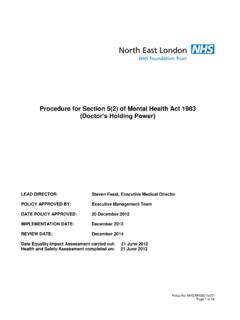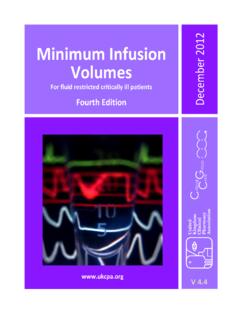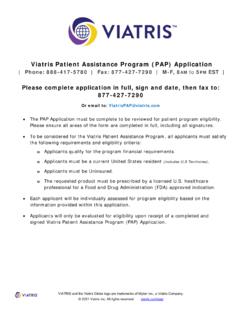Transcription of Critical Care Intravenous Drug Administration Guide - SGUL
1 CCrriittiiccaallCCaarreeIInnttrraavveenn oouussDDrruuggAAddmmiinniissttrraattiioo nnGGuuiiddee For Use on ICU, HDU & CTCCU Page 1 of 44 April 2008 (For review April 2009)DRUGMETHODADMINISTER OVERDILUTION & DILUENTY-SITE COMPATIBILITY & pHMONITORING, ADVERSE EFFECTS & COMMENTSA cetylcysteineInfusion for liver failure15mg/kg loading dose then over 24 hours for 5 dayspH: 7 adjusted with sodium not infuse with other drugs if possibleA change in colour to light purple does not indicate any change in safety or of NS as diluent is not in product licence but manufacturer has stability data.
2 Infusion for paracetamol overdose150mg/kg loading dose over 15 minutes, then 50mg/kg over 4 hours, then 100mg/kg over 16 hoursCentral line:May be given undilutedPeripheral line: Minimum dilution each 10ml ampoule with 10mls of G or NSUsually dilute daily dose in 100mls NS or GFlush: G or NSSodium content: mmol/10mlInfusion for renal protection against contrast media3 mls (600mg) of 2g in 10ml injection100mls G or NS, infuse over to section 4 for more : 600mg BD day before and day of scanAciclovirIntermittent InfusionMinimum 1 hour with adequate hydration (aciclovir can precipitate in renal tubules if maximum solubility is exceeded)Reconstitute vial to 25mg/ml with W or NS if dry powder.
3 Dilute to a concentration not greater than 5mg/ml with NS or dilute doses of 250-500mg in 100ml and 500mg-1g in a minimum of give undiluted (25mg/ml) via central line over at least 1 hour (unlicensed practice)Compatible: ampicillin, cimetidine, cefotaxime, ceftazidime, fluconazole, gentamicin, heparin, magnesium, piperacillin, ranitidine, vancomycinIncompatible: amifostine, amsacrine, aztreonam, diltiazem hydrochloride, dobutamine hydrochloride, dopamine hydrochloride, fludarabine phosphate, foscarnet sodium, idarubicin hydrochloride, meropenem, morphine sulphate, ondansetron hydrochloride, pethidine hydrochloride, piperacillin sodium - tazobactam sodium, sargramostim and vinorelbine : 11 Only stable at concentrations of 25mg/ml or 5mg/ml or less.
4 High concentrations are associated with thrombophlebitis and irritation at injection : May cause tissue damageFlush: NS Sodium content: mmol/250mgShould any visible turbidity or crystallisation appear in the solution before or during infusion, the preparation should be IV bolus given by a doctor or under direct supervision2 secondsCan be diluted with NSCompatibility with other medicines is not known. pH - with rapid NS flush (at least 20mls).Monitor: Bronchospasm, bradycardia, facial flushing, dyspnoea and tightness in chest.
5 Requires ECG content: mmol/vialCCrriittiiccaallCCaarreeIInnttr raavveennoouussDDrruuggAAddmmiinniissttr raattiioonnGGuuiiddee For Use on ICU, HDU & CTCCU Page 2 of 44 April 2008 (For review April 2009)DRUGMETHODADMINISTER OVERDILUTION & DILUENTY-SITE COMPATIBILITY & pHMONITORING, ADVERSE EFFECTS & COMMENTSA drenaline(Epinephrine)Infusion via central line with pumpTitrate to responseGeneral ICU/HDUD ilute 5mg in 50ml, 10 mg in 50ml or 15 mg in 50ml G (or NS)
6 Refer to Y-Site Compatibility ChartCompatible: atropine (in G only), : lignocaineStrengths above 15mg in 50ml should be reserved for exceptional circumstances or if requested by stable in NS. Infusions are given by central line, in emergency situations bolus doses may have to be given by peripheral iv ICUD ilute 2mg, 4mg, 8mg or 16mg in 50ml G (or NS)Monitor: BP, HR, intra-arterial or PCW catheter blood pressure and cardiac monitoringIV bolus under supervision of a doctor1mg in 10ml (1 in 10,000) MinijetpH: : may cause tissue damageDo not InfusionNormal blood volume: 1-2ml/minHypovolaemia or shock: up to 1 L/hourPlasma exchange.
7 Up to 30ml/minuteUndiluted Do not mix with any other drugs, infusions or blood productspH: not use if turbid or contains a depositMonitor: rarely allergic reaction. Use within 3 hours of piercing container sealSodium content: 20% contains 50-120 contains 100-160 mmol/LAlbumin 20%InfusionNormal blood volume: 1-2ml/minuteHypovolaemia or shock: up to 120ml/hourAlfentanilContinuous Infusion with pumpLoading dose 50-100 micrograms/kg over 10 mins or less followed by infusion titrated to effectDiluted 1mg/ml with G or NS or HRefer to Y-Site Compatibility ChartpH: sedation score and pain tool to titrate to effectMonitor.
8 BP, HR, RR, respiratory depression, apnoea, bradycardia, hypotension. Ensure maintenance of bolus(under supervision of a doctor in non ventilated patients)Minimum 30 seconds in spontaneously breathing patientsFlush: NS or GCCrriittiiccaallCCaarreeIInnttrraavveen noouussDDrruuggAAddmmiinniissttrraattiio onnGGuuiiddee For Use on ICU, HDU & CTCCU Page 3 of 44 April 2008 (For review April 2009)DRUGMETHODADMINISTER OVERDILUTION & DILUENTY-SITE COMPATIBILITY & pHMONITORING, ADVERSE EFFECTS & COMMENTSA lteplase(Recombinant human tissue-type plasminogen activator) IV bolusAccelerated regimen in MI: give 15mg as a bolus over 2 minutes, followed by.
9 Dilute each vial with water for injection provided. If necessary further dilute with NS to concentration of or : Do not use W or G for dilution. Heparin, GTN, dobutamine, dopamine. Manufacturers recommend do not mix with any other drugsReconstituted vial stable for 24 hours in the fridge or 8 hours at room : reperfusion arrhythmias, increased risk of bleeding. May rarely cause allergic infusion50mg over 30minutes, and then 35mg over dose in patients <65kg as per SPC pH : NSAmikacinIV bolus2 - 3 minutes for doses less than 500mgCan be diluted in 10 - 20ml NSCompatible: metronidazole,ranitidine, vancomycinIntermittent Infusion30-60 minutesDilute with 50-100ml NS, concentration in : amphoteracin, cephalosporins, erythromycin , penicillins, phenytoin, potassium chloride, heparin, thiopentone, tetracyclines, vitamins B and C, nitrofuranoin, warfarinpH.
10 Level monitoring required. Usually givenonce daily at 12noon, dose 15-20mg/kg. Troughlevel taken at 6am should be less than 5 : NS, GSodium content: may darken from colourless to pale yellow but this does not indicate loss of infusion with a pumpLoading dose 5mg/kg over at least 20 minutes then continuous infusion of 500 micrograms/kg/hourUsually diluted 500mg in 250 to 500mls (1-2mg/ml) in NS or use undiluted (25mg/ml) via central line at rate not exceeding 25 to Y-Site Compatibility ChartCompatible: calcium gluconate, meropenem, : cefotaxime, ciprofloxacin, clindamycin, hydralazine.




